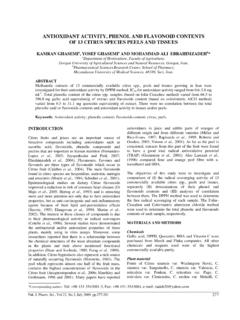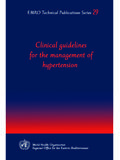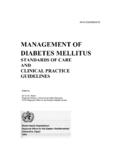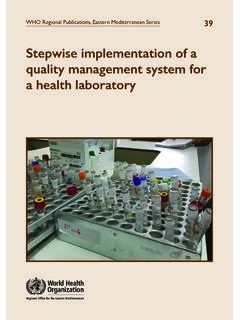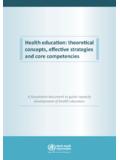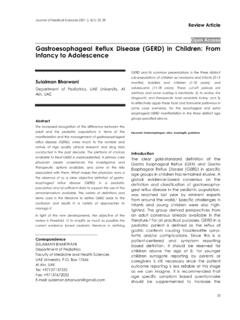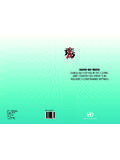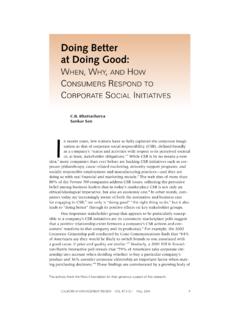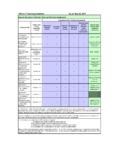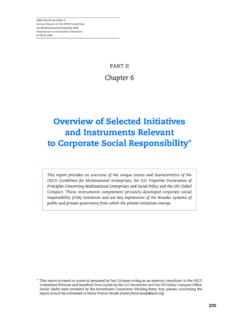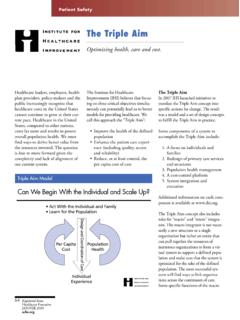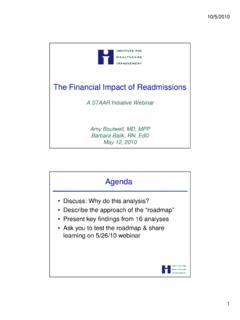Transcription of Community-Based Initiatives Series 14
1 Monitoring, supervisory and evaluation tools for Community-Based initiativesCommunity- based Initiatives Series14 Monitoring, supervisoryand evaluation toolsfor Community-Based initiativesCommunity- based Initiatives Series14 World Health Organization 2010 All rights designations employed and the presentation of the material in this publication do not imply the expression of any opinion whatsoever on the part of the World Health Organization concerning the legal status of any country, territory, city or area or of its authorities, or concerning the delimitation of its frontiers or boundaries. Dotted lines on maps represent approximate border lines for which there may not yet be full mention of specific companies or of certain manufacturers products does not imply that they are endorsed or recom-mended by the World Health Organization in preference to others of a similar nature that are not mentioned.
2 Errors and omissions excepted, the names of proprietary products are distinguished by initial capital reasonable precautions have been taken by the World Health Organization to verify the information contained in this publication. However, the published material is being distributed without warranty of any kind, either expressed or im-plied. The responsibility for the interpretation and use of the material lies with the reader. In no event shall the World Health Organization be liable for damages arising from its use. Publications of the World Health Organization can be obtained from Health Publications, Production and Dissemination, World Health Organization, Regional Office for the Eastern Mediterranean, Box 7608, Nasr City, Cairo 11371, Egypt. tel: +202 22670 2535, fax: +202 227650424; email: Requests for permission to reproduce, in part or in whole, or to translate publications of WHO Regional Office for the Eastern Mediterranean whether for sale or for noncommercial distribution should be addressed to Regional Adviser, Global Arabic Programme, WHO Regional Office for the Eastern Mediterranean, at the above address: email: Design and layout by Pulp PicturesPrinted by WHO Regional Office for the Eastern Mediterranean, CairoWHO Library Cataloguing in Publication DataWorld Health Organization.
3 Regional Office for the Eastern MediterraneanMonitoring, supervisory and evaluation tools for Community-Based Initiatives / World Health Office for the Eastern Mediterraneanp. ( Community-Based initiative Series ; 14)ISBN: 978-92-9021-744-2 ISBN: 978-92-9021-745-9 (online)1. community Health Planning 2. Financing, Organized 3. Health Status Indicators 4. Program Evaluation5. Community-Based Participatory Research I. Title II. Regional Office for the Eastern Mediterranean (NLM Classification: WA 546) Community-Based InitiativesContentsIntroductionSite profileMonitoring and supervisory checklistMonitoring and supervisory checklistQuarterly report1. Projects and coverage2. Health and social indicators3.
4 Number of meetings, training and supervisory visits 4. Loan and recovery funds (in local currency)5. Financial statementEvaluation tool Country profileSource of fundsProject profile: health, social and economic growthBaseline survey to evaluate CBIP roposed plan of action for evaluationEvaluation tool for field workNational commitment assessment591720232525262626273030313233 3439 IntroductionCommunity- based InitiativesIntroductionAbout the toolsThis publication comprises monitoring, supervisory and evaluation tools for Community-Based Initiatives (CBI). It has four sections: site profile, monitoring and supervisory checklist, quarterly report and evaluation tool. Each section has a specific purpose and should be used in a specific location following a particular methodology. These four separate tools have been combined into one manual in order to simplify the task of the local/national evaluators and to ensure a common methodology is followed.
5 All four tools follow the same structure. This will enable data comparison over different periods of time and identification of the successes and failures of the local/national Community-Based Initiatives programme. The tools are all based on the following nine major areas which are fundamental to the CBI implementation process: community organization and mobilization Intersectoral collaboration and partnership Community-Based information system Water, sanitation, and food safety Health development Emergency preparedness and response Education and literacy Skills development, vocational training and capacity-building Micro-credit activitiesNote: all the forms in this manual can be modified based on the country s needs and requirements, and matched with local structure and health and socioeconomic profileThe site profile is a form used to obtain a general overview of the selected implementation site.
6 The implementing sites are expected to provide (upload) similar data to RASDOON, the regional web- based surveillance system. The general information obtained by this form is extremely useful during the initial stage of the monitoring process. The tool covers: demographic information, management of health facilities, availability of the basic infrastructure and social facilities, community organization (clarifying the number of trained cluster representatives, members of the village/ community development committee (VDC/CDC), education, health and sanitation status, major Community-Based interventions and a brief on community needs and plans for the and supervisory checklist24 key questions were incorporated in this short precise tool which can facilitate an evaluator s job to attain useful and specific data during supervision and monitoring visits to the implementation sites.)
7 The responses retrieved will provide an overview of the impact of interventions; highlighting areas of success and the major areas that require improvement. Since each question is highly variable, the questionnaire enables a quick overview of the actual situation in each intervention site. This questionnaire simplifies the supervision process of the implementation site since it can be completed within a day visit to the site. 8 Monitoring, supervisory and evaluation tools for Community-Based initiativesThe 24 questions are direct derivatives of the Community-Based Initiatives self-monitoring tool:100-point Thus, this tool will encourage VDCs, CDCs and project managers to use the 100 point check list as a mechanism for the long reportThe quarterly report should be completed at the peripheral level every 3 months to attain important information from implementation sites.
8 A manager can monitor the progress of the programme through receiving regular reports/feedback on the programme s achievements and obstacles. The CBI quarterly report will complement the findings of the supervisor s field visits and other reports received from the implementation sites. Well structured reports will also have a positive impact on the performance of CBI field staff and community representatives as they will provide solid evidential data to work with demonstrating CBI site performance. Moreover, information received through a standard quarterly report tool can facilitate the preparation of regional reports, expansion plans, advocacy and training toolThe existing evaluation tool is a user-friendly practical and comprehensive tool. It has been adapted in accordance with the supervisory and monitoring tools discussed above.
9 The tool covers nine fundamental areas essential to the CBI programmes, both at the national and local levels. The evaluation can be performed through field visits, interviews and checking reports and existing data available in implementation sites. The evaluation tool facilitates interviews with all stakeholders including community representatives, members of VDC/CDC, teachers, women and youth groups, partners, and programme Community-Based Initiatives self-monitoring tool: 100-point checklist. Cairo, WHO Eastern Mediterranean Regional Office, profileCommunity- based Initiatives1. General Information Name of the country: Name of the governorate or state or province: Name of the district or locality or municipality: Name of the demonstration site: Type of the demonstration site (select only one) :RuralUrbanNote: BDN can be either rural or urban depending on the site s location and characteristics Specify in which year the programme started at this site: Which type of interventions is this site experiencing?
10 (select only one)Basic Development Needs (BDN)Healthy Cities Programme (HCP)Healthy Villages Programme (HVP)2. Demographic information Number of households:Male Female Number of the population under 15: .. Number of the population above 15: ..3. Management of health facilitiesIs any health facility available at this site? Yes NoIf yes, select the type of staff responsible for running the health facility at the site:DoctorsNursesMidwives DispensersHealth workersHealth volunteers/activistsOthers (specify) Site profile12 Monitoring, supervisory and evaluation tools for Community-Based initiatives4. Availability of basic infrastructure and social facilitiesPlease select the available facilities in this site (select all that apply): Mobile health team Trained birth attendants Primary school Secondary school Electricity Bank Safe drinking-water (partial)System for garbage collection and disposal of wastePaved roads to the closest city/townPublic transportation to closest city/town5.
